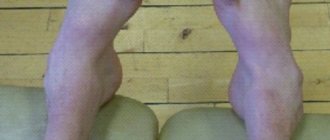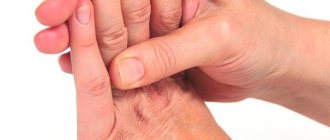The left arm and leg go numb at the same time because the nerve roots and blood vessels are compressed. In this case, innervation is disrupted, blood does not flow into the tissues. As a result, neurological deficit occurs.
Select the background for which condition you experienced numbness:
- After sleep (23%, 282)
- Inactivity (19%, 231)
- Stress (18%, 212)
- Overwork (13%, 157)
- Alcohol intoxication (12%, 139)
- Lack of sleep (10%, 121 Votes)
- Hypothermia (4%, 44)
- Poor nutrition (2%, 20)
Total voters: 1 206
Loading …
Consult a doctor!
The site provides reference information . Adequate diagnosis and treatment of the disease is possible under the supervision of a conscientious doctor . Any medications have contraindications. Consultation with a specialist and detailed study of the instructions is necessary! Be sure to make an appointment with your doctor .
Why does my left arm and leg go numb at the same time?
The pathology manifests itself as partial or complete paresis in the limbs, mild tingling, and a burning sensation.
The phenomenon is short-term or protracted and poses a health hazard due to complications. The left arm and leg go numb at the same time because:
- Being in one position for a long time causes compression of the nerve;
- There are side effects from medications taken;
- The cause of numbness will be severe stress or hypothermia;
- Nerve damage during surgery, joint deformation;
- From deficiency of vitamins and microelements in the body.
Simultaneous numbness of the left extremities is a symptom that manifests itself in a number of diseases that are associated with the brain:
- Hemorrhage, stroke - occurs due to circulatory problems in the brain;
- Tumors of the right hemisphere of the brain will cause various forms of neurological disorders that cause numbness of the limbs;
- Viral inflammation of the brain – encephalitis;
- Head injuries, intracranial hematoma.
Weakness of the limbs, which is accompanied by pain, signals a neurological or systemic disease:
- Pinched, damaged or inflamed spinal nerve;
- The presence of a hernia in the sacrolumbar spine, disc displacement, spinal injuries;
- Varicose veins, multiple sclerosis, diabetes, alcoholism;
- Disruption of the connection between peripheral nerves and the central nervous system, osteochondrosis;
- Vascular diseases, heart diseases, Raynaud's syndrome, systemic diseases, rheumatoid arthritis, atherosclerosis, pathologies of peripheral arteries;
- Angina pectoris, ischemia, myopathy, heart attack, high blood cholesterol.
With osteochondrosis, the fingertips first begin to go numb, pain appears, and the muscles of the entire limb weaken. The speed of spread depends on the degree of slagging in the body.
Additionally, Raynaud's disease causes blue fingers, coldness, and decreased strength. Attention should be paid to paresis of the little finger - a symptom of an impending heart attack.
Neuropathy is caused by activities that require prolonged tension of the limbs, needlework, uncomfortable sleep, and monotonous movements.
Physiology
Why does the left arm and leg go numb? The cause of the discomfort is not always a pathological process. The following can lead to numbness of the extremities:
- Office work, when a person spends a long time sitting at a computer. Carpal tunnel syndrome appears
- Sleeping in an uncomfortable position causes numbness at night,
- The habit of sitting with your legs crossed. Leads to pinched nerve endings in the leg,
- Prolonged stay in a position in which the left arm is raised,
- Wearing narrow-toed shoes or tight clothing.
What treatment is prescribed
The diagnosis is made by a neurologist based on a survey, examination, reflex testing, laboratory and hardware examination of the patient.
Having made a diagnosis, treatment is prescribed:
- Conservative – drug therapy for a chronic disease that has led to circulatory problems;
- Surgical – nerve root decompression, operations on blood vessels, disc herniations and other organs requiring surgical intervention;
- Physiotherapy.
If the pathology is not eliminated in time, complications will occur that will lead to chronic diseases. To prevent this from happening, you need to lead a healthy lifestyle, eliminate smoking, alcohol, and drugs from your habits, avoid hypothermia, and not stay in an uncomfortable position for a long time.
Poor circulation occurs with a sedentary lifestyle. Exercising, comfortable sleep, and walking will reduce the risk of pinched nerves.
It may be enough to do warm-up exercises or a light massage to quickly restore innervation.
When doing monotonous work, you need to take breaks and warm up. If numbness recurs regularly, consult a doctor.
Why does my left hand go numb?
The main reasons why the left arm and leg go numb lie in the spine. Symptoms such as numbness in the fingers of the left hand are no exception. In this case, the most likely factor is pinching of nerve fibers in the cervical spine due to the development of osteochondrosis. The culprit is often the presence of an intervertebral hernia. In this case, discomfort will be felt in the fingertips.
Common causes of numbness in the fingers of the left hand and other parts of it are pathologies of the cardiovascular system. They cause accompanying symptoms, such as a feeling of coldness in the limb, its blueness. The possibility of diabetes mellitus and some systemic diseases should not be excluded.
If numbness in your left hand is constantly felt, you should definitely consult a doctor. In addition to the above facts, such a symptom is a precursor to a stroke, the consequences of which are often dire. To avoid such a fate, it is better to prevent the onset of the disease and carry out timely therapy.
Which doctor should I contact if a symptom appears?
If numbness in the hand occurs regularly or for a long time, the help of a specialist is required.
Doctors can help determine the cause of loss of sensitivity after examination:
- Cardiologist;
- Therapist;
- Neurologist.
This is due to the possibility of numbness of the hand occurring due to the development of diseases in the area of their specialization.
If there is no specific suspicion of the cause of the symptom, you need to contact your local physician, who will prescribe general procedures. This is required to identify the area where the pathology occurs and refer you to the right specialist.
Pain in the heart area that accompanies numbness of the arm or part of it requires the attention of a cardiologist. Without additional symptoms, an initial consultation with both a local therapist and a neurologist is possible.
Based on the results of the examinations, it may be necessary to contact such doctors as:
- Orthopedist;
- Surgeon;
- Rehabilitologist;
- Osteopath.
Left leg goes numb: reasons
It is difficult to establish the exact cause of numbness in the left leg, even taking into account modern diagnostic schemes. There are a number of diseases that directly or indirectly affect the processes of innervation and blood circulation of the lower extremities.
The symptom is based on a violation of nerve conduction and microcirculation in the legs. The correlation depending on gender (men: women) is estimated as 1:2.
List of main reasons:
| Cause | Explanation |
| Neurological disorders | The symptom may be associated with damage to the nervous tissue of the limb itself (tunnel syndrome), but can also occur in other parts of the nervous system (sciatica). |
| Intervertebral hernia and other spinal diseases | There is numbness in both the left leg and the right. |
| Pathologies of the cardiovascular system | The second most common group of diseases that indirectly lead to impaired sensitivity in the lower extremities. They are associated with impaired blood flow (blockage of blood vessels with atherosclerotic plaques or blood clots) and the development of ischemia (lack of nutrients and oxygen in tissues). A person does not immediately begin to feel numbness in the foot of his left or right leg, but only as the disease progresses (thrombosis, varicose veins of the lower extremities, atherosclerosis). |
| Oncological diseases | Benign or malignant formations often have an indirect effect on the normal nutrition of tissues (they compress, block the blood flow, grow into blood vessels). |
| Stroke | There is hemorrhage in the brain and damage to the parts responsible for processing motor and sensory impulses. There is a partial or complete disruption of hand function (especially fine motor skills), walking, and orientation in space. The severity of symptoms will depend on the degree of hemorrhage. |
| Polyneuropathies accompanying type I diabetes mellitus. | The syndrome is associated with impaired transport of glucose into tissues (malnutrition). Manifestations most often occur on the sole, shin and affect the knee. The reason is the peculiarities of blood circulation in the lower extremities. |
| Diseases of the musculoskeletal system (osteochondrosis, fractures) | Fractures in some cases can lead to compression or cutting of nerve fibers. |
| Autoimmune diseases such as rheumatoid arthritis | Most often it affects large joints (knee, shoulder, hip). |
Indirect factors accompanying the progression and occurrence of numbness:
- obesity grade II–III;
- incorrectly selected shoes;
- hypothermia;
- lack of vitamins and microelements;
- pregnancy.
Long-term compartment syndrome includes a symptom such as numbness, but in this case the sensation is short-term.
Diagnosis of the disease
Treatment for stiffness of the limbs is aimed at eliminating the cause that caused this condition. A disease is detected, one of the symptoms of which is partial or complete loss of sensitivity in one or two hands at once. This requires a range of research methods.
In order to diagnose the cause of the symptom of hand numbness, after an initial medical examination, a series of examinations may be prescribed.
Among them are laboratory tests:
- General blood analysis;
- Blood test for hormones;
- Vitamin analysis.
Upon receiving the results of laboratory tests, the doctor draws up a general preliminary picture of the state of health.
To do this, he systematizes and analyzes information:
- Obtained data from laboratory tests;
- Results of external examination of the patient;
- Symptoms of numbness based on the patient’s complaints. Comparison of additional signs accompanying numbness.
Based on the generalized information, an examination is prescribed. This is required to confirm or refute suspicions of the presence of specific disorders in the activity of a particular area of the body.
The main task of the doctor is to determine the cause of the loss of sensitivity in the hand. The collected material is examined to exclude simple mechanical compression of blood vessels, household and industrial factors not related to diseases.
Woodiness can be a harmless temporary manifestation of a separate physical impact, but it can also be a factor indicating the development of serious pathologies and disturbances in the normal functioning of internal organs.
Myocardial ischemia, stroke, diabetes mellitus, problems in the spine and a number of other diseases can be hidden under such a symptom as numbness in the arm. Often numbness occurs as a result of the progression of osteochondrosis.
To identify the disease itself and the extent of damage to the body, the patient is sent for specific examinations.
Frequently prescribed examinations:
- Radiography. Detects damage to the spine, the presence of hernias, displacements of intervertebral discs, the appearance of neoplasms, curvature, the development of degenerative pathologies, and infectious diseases.
- Magnetic resonance imaging. Prescribed for suspected radicular syndrome - compression of the spinal nerves.
- Ultrasound duplex scanning. Allows you to determine the patency of veins and arteries, the presence of blood clots in them. Examines the walls of blood vessels, detects abnormal changes, evidence of blockage, and the presence of plaques.
- Ultrasound.
- EEG. It is carried out when there is a suspicion of disturbances in the functioning of the central nervous system.
- CT scan.
- Electroneurography. A study of the nervous system allows you to assess the extent of nerve damage.
- Electromyography. The method consists of recording electrical muscle activity, which makes it possible to determine the speed of nerve impulses transmitted. It is used to assess human motor dysfunction in orthopedics.
- UZDS. Shows blood flow in the area being examined.
The examinations can be prescribed separately or in combination with each other to create a more complete picture of the health status of the body and its individual organs.
When does your left leg go numb?
The most common reason why the left leg goes numb is a disorder in the nervous system. The source sometimes lies in vascular damage or the presence of systemic diseases. In this case, numbness and unpleasant sensations in the form of tingling and burning are felt above the knee, in the lower leg, in the foot and in the fingers. It is the location of the symptom that will indicate the possible presence of the disease.
Numbness of the left leg in the foot area and especially the toes often indicates the presence of an intervertebral hernia in the lumbar spine. In this case, it will be accompanied by tingling and pain. If you do not begin to treat the underlying ailment in time, then there is a high probability that the discomfort will worsen, the foot will begin to weaken, which will complicate the process of walking.
Common reasons why the left leg goes numb in various parts of it are varicose veins and thrombosis. Numbness is also observed after injuries or due to severe frostbite. Stroke, diabetes, and multiple sclerosis also sometimes cause this symptom. Quite often, this symptom occurs in people suffering from alcoholism.
Preventive methods
Numbness of the limbs causes discomfort and hinders movement. It is possible to reduce the severity of symptoms, and sometimes eliminate them completely, through systematically implemented preventive measures.
The most effective measures include:
- Moderate physical activity. Represents the daily implementation of a set of specially designed health-improving exercises. This allows you to constantly keep the arm muscles in good shape and strengthen their resistance to numbness. Physical activity is important for diseases of blood vessels and joints.
- Proper nutrition, excluding fatty and spicy foods from the diet. Inclusion of fruits, herbs, vegetables, fish, vegetable oils
- Reduce salt intake.
- Stop drinking alcohol and nicotine.
- Protection from the cold. Freezing your hands has a negative effect on the condition of your joints. Treat them with care - keep them warm, wear clothes mainly made of natural fabrics. In cold weather, wear gloves and mittens.
- A small physical warm-up for the arms, alternating with a load on the hands and palms. Circular rotations of the hands have a beneficial effect on relieving muscle tension during work involving heavy loads on the upper limbs and spine. When working with your hands for a long time, take a break every 45 minutes for a massage. This will restore blood circulation and prevent blood stagnation.
Hand exercises
To reduce the severity of symptoms of numbness in the upper extremities and prevent the frequency of manifestations of the uncomfortable condition, it is recommended to improve blood circulation in the hands with therapeutic exercises.
The set of developed exercises can be common for all areas of the arm that are susceptible to numbness, or changed separately for each of them.
Numbness due to carpal tunnel syndrome is common. It accounts for more than 60% of all cases. It is characterized by loss of mobility in the fingers and hands up to the wrist. Less often - up to the elbow or shoulder. Gymnastic exercises for illness give the greatest therapeutic results.
Damage to the spine, the formation of intervertebral hernias, and displacement of joints cause numbness in the hand in 30% of cases. All other diseases lead to a loss of hand sensitivity of 10%.
Gymnastics are carried out to reduce symptoms. The symptom can be completely eliminated only after treatment of the underlying disease.
Exercises for hands and fingers:
- The palms folded together are placed in a vertical position in front of the chest. Rubbing movements are carried out with the palms for 2 minutes.
- The fingertips of both hands touch each other, and they make short pressing movements for several minutes.
- Fingers or other problem areas of the upper extremities are massaged. Rubbing massaging movements are carried out in a clockwise direction. Attention, when concentrating the loss of sensitivity in the area of the hand, is given to the tips of the index fingers. The massage is carried out alternately, first for one, then for the other hand.
- Vigorously clench and unclench your hands for a few seconds. Alternates with light finger massaging.
- Squeezing a tennis ball with your palms.
Exercises for the shoulder and forearm area, elbow area:
- Massage with short pressure on a point on the forearm. Performed 20 times for each shoulder. The point is found by measuring a distance of 3 fingers from the bend line of the elbow towards the hand.
- Raising and lowering the arm with a delay of several seconds in each position. Performed alternately 10-15 times for each limb.
- Adopting a lying position. Raising your hands, clenching your palms into fists and unclenching them several times. Lowering your arms, stretching them along your body, relaxing your muscles. The exercise is repeated 8-10 times.
Exercises are carried out when a symptom of numbness appears. For prevention, they are performed systematically, depending on the frequency of hand numbness - 3 or 4 times a week. In case of frequent loss of hand control - daily.
Numbness of the limbs
24934 21 August
IMPORTANT!
The information in this section cannot be used for self-diagnosis and self-treatment.
In case of pain or other exacerbation of the disease, diagnostic tests should be prescribed only by the attending physician. To make a diagnosis and properly prescribe treatment, you should contact your doctor. Numbness, or paresthesia, is a disorder of the sensitivity of body tissues that occurs due to damage to the peripheral nervous system.
It can be accompanied by various sensations: from tingling, goosebumps to a general decrease in sensitivity of any part of the body, most often the limbs.
The patient feels any tactile influence as if through a layer of cotton wool.
Varieties
Depending on the duration and location, several types of paresthesia are distinguished. Temporary or transient paresthesia may be due to decreased blood flow (ischemic). This type of numbness occurs when there is spasm or compression of the vessels of the limb. Permanent paresthesia is also possible when nerve fibers are crossed or compressed during surgery, trauma, cancer and degenerative changes in the musculoskeletal system.
Reasons for appearance
An example of transient paresthesia is sensory disturbance during a hypertensive crisis.
. This condition is characterized by a sudden increase in blood pressure and is accompanied by symptoms such as severe headache, dizziness, nausea, vomiting, visual disturbances, spots before the eyes, and paresthesia of the extremities.
It should be noted that the clinical symptoms of a crisis can be observed even at low pressure values; the main role is played by the suddenness and difference in the difference between systolic and diastolic pressure.
Raynaud's syndrome
is an episodic disturbance of blood circulation in the extremities due to a sharp spasm of peripheral vessels in response to cold exposure or emotional stress, which quite often causes loss of sensitivity. Most often, the fingers are affected, which from exposure to cold become almost white or bluish-violet and lose sensitivity. After the spasm stops (usually after 15-20 minutes), blood flow in the extremities is restored, as evidenced by the normalization of skin color and sensitivity.
Tunnel or compression syndromes
are among the most common causes of numbness of the extremities. Compression (compression) of the nerve fiber, located in the narrow space between the bone and muscles of the limb, occurs due to swelling that occurs with injuries to the joints and ligaments.
The first symptoms of this condition are pain, sometimes a sensation of current passing (electrical shooting), numbness, weakness and dysfunction, which subsequently lead to muscle atrophy and loss of motor ability of the limb.
Compression of the nerve roots (
radiculopathy
) due to herniated intervertebral discs and tumors is also accompanied by numbness of the limb. Depending on what level of the spine the nerve is pinched, pain and numbness in certain parts of the limb, impaired reflexes, muscle weakness, stiffness in the spine, and pain in the projection of the affected root when coughing or sneezing may occur.
With radiculopathies, pain increases in an upright position of the body and decreases in a lying position.
Polyneuropathies
can cause numbness in the extremities . A sign of polyneuropathy is symmetrical damage to the limbs. Multiple damage to peripheral nerves occurs due to decreased nutrition of nerve fibers (metabolic polyneuropathy). A typical example of peripheral nerve damage is diabetic polyneuropathy. It is characterized by slow progression and gradual development of motor and sensory disorders. Alcoholic polyneuropathy develops much faster.
Its characteristic symptoms include numbness and loss of sensation in the lower extremities, starting with the feet, and soreness of the calf muscles. Later, these symptoms are accompanied by weakness and paresis (decreased muscle strength) of the limbs.
Paresthesia can occur with drug-induced polyneuropathy when taking certain drugs, with uremic polyneuropathy in patients with chronic renal failure, as well as with other diseases.
Paresthesia, a feeling of numbness and pins and needles are the main signs of B vitamin deficiency
. In particular, with a lack of thiamine (B1), polyneuropathy develops, which is manifested by a “pins and needles” sensation.
Cyanocobalamin (B12) deficiency
leads to degenerative changes in the spinal cord, which are accompanied by a feeling of numbness, tingling in the limbs, gait disturbance, memory loss and loss of tendon reflexes.
Similarly, with hypocalcemia
(lack of calcium in the blood), paresthesia and seizures are the leading clinical manifestations of the disease. Calcium deficiency can develop against the background of pancreatitis, sepsis, hormonal disorders (in particular, with hypoparathyroidism), blood loss during major operations and injuries.
Among the demyelinating lesions
diseases that cause numbness in the extremities include multiple sclerosis.
With this disease, demyelination (destruction of the myelin sheath) of nerve fibers occurs in various parts of the central nervous system, which significantly disrupts the conduction of impulses through neurons.
Sensory impairment is one of the earliest and most common symptoms of multiple sclerosis. The patient experiences a transient feeling of numbness, “pins and needles” in various parts of the body, most often in the tips of the toes or hands. This sensitivity disorder is focal in nature.
Loss of sensitivity in the limbs, numbness occurs with polymyalgia rheumatica
. This is an inflammatory disease of the musculoskeletal system that develops after the age of 50. Severe pain in the symmetrical muscles of the shoulders, hips, and neck is combined with an acute inflammatory process. The pain intensifies with movement and does not subside even at night. Muscle stiffness is typical both in the morning and after prolonged immobility. Muscle damage is combined with peripheral arthritis, often on one side, which is accompanied by a slight disturbance of sensitivity and paresthesia.
Occupational hazards, exposure to ultrasound
also lead to sensory and vascular disorders. People who are exposed to vibration for a long time develop increased sensitivity of their hands to cold and periodically experience numbness in their fingers. The skin takes on a cyanotic, marbled color and becomes cold and damp to the touch. Over time, dystrophic changes spread to nerve fibers, muscles, and bones.
Diagnostics and examination
Diagnosis of a disease accompanied by numbness begins with interviewing the patient, which makes it possible to clarify the location and nature of the sensitivity disorder. To exclude the metabolic nature of the disease, blood tests (general clinical and biochemical), determination of the level of glycated hemoglobin, urea in the blood, liver enzymes), calcium levels, vitamin B12 and methylmalonic acid, C-reactive protein and a general urinalysis are necessary.
Traditional methods of treatment
Remedies used in traditional medicine are recommended for use only in combination with the main treatment. A preliminary consultation with a doctor about the possibility of side effects as a result of taking the medication is required.
Alternative medicine methods used to eliminate the symptoms of numbness of the upper extremities:
- Taking a bath with rosemary before bed. An infusion prepared within half an hour from 3 liters of water and a handful of flowers is added to a bath filled with water. Take a bath for a quarter of an hour.
- Rubbing numb areas of the hand with a product prepared from camphor (10 ml) and ammonia (50 ml) alcohols. The resulting mixture is diluted with one liter of water at room temperature. One spoon of table salt is added to the finished product.
- Numbness of the elbow is treated with boiled wheat porridge, folded into a fabric bag. To obtain relief that occurs immediately, the bag is applied to the elbow and held for half an hour.
- Garlic cloves cut into slices are infused in vodka for 2 weeks. Take orally 2 times a day before meals, 5 drops of the product diluted in one teaspoon of water. The duration of the course of treatment is one and a half months.
- Tying the wrist with woolen thread.
- Powdered round black pepper is poured with vegetable oil and left for half an hour with occasional stirring. The resulting product is rubbed warm into problem areas 2 times a day.










